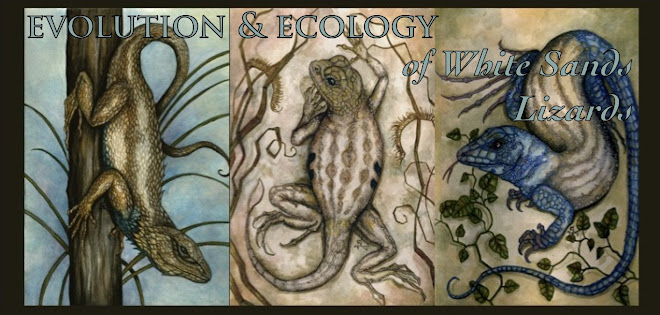 Sceloporus undulatus, The Eastern Fence Lizard.
Sceloporus undulatus, The Eastern Fence Lizard.If I may go ahead and say so, Scelops has the most draconic-like attitude of the three White Sands lizards. Never reluctant to bite (which was actually ideal for testing their bite force last year), these little guys are feisty! They're sit-and-wait foragers, which means they hang around basking (mostly on yucca stalks*) until a tasty little arthropod morsel wanders their way. In White Sands, Scelops have lost their colour due to a mutation in the melanin gene, MC1r (1). They have slightly longer legs, and broader heads than their dark-soil counterparts, although the difference is not significant (2).
Aspidoscelis inornata, The Little Striped Whiptail
 Otherwise known as, the very hardest little lizard to catch! These slender striped lizards are active foragers... instead of waiting around for their food to crawl by, they go hunting for it. They will even burrow into the soft sand in search of insect larvae. Both males and females are blue, and the colour is presumably used in signaling to other Aspis. In White Sands, Aspis are significantly larger than in the surrounding desert. They have longer legs, broader heads (2) and like Scelops have a mutation in MC1r (1) that has resulted in colour loss (although not in the same location in the gene).
Otherwise known as, the very hardest little lizard to catch! These slender striped lizards are active foragers... instead of waiting around for their food to crawl by, they go hunting for it. They will even burrow into the soft sand in search of insect larvae. Both males and females are blue, and the colour is presumably used in signaling to other Aspis. In White Sands, Aspis are significantly larger than in the surrounding desert. They have longer legs, broader heads (2) and like Scelops have a mutation in MC1r (1) that has resulted in colour loss (although not in the same location in the gene).
Holbrookia maculata, The Lesser Earless Lizard.
Holbrooks is the protagonist of our story this field season. Holbrooks on White Sands are extremely divergent in colour from their darker cousins; however, the mutation which causes colour loss is unknown and not located in the coding region of MC1r (1). White Sands Holbrooks also have longer legs and broader heads (2). Like Aspis, they'll burrow in the ground, but like Scelops they are sit and wait foragers. This year, we'll be performing a mark-recapture experiment in which we evaluate current natural selection on Holbrooks. Stay tuned for my next blog where I will explain our very exciting experiment!
~ Simone

No comments:
Post a Comment